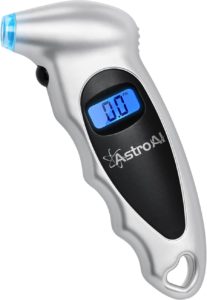Steps to Reset Mazda CX-50 Tire Pressure Light
Step 1: Check and Adjust Your Tire Pressure
Since the latest Mazda models, such as the CX-50, no longer featuring tire pressure reset buttons, it’s crucial to know how to switch off the tire pressure warning light. Start by opening the driver’s side door and locating the yellow sticker in the door jamb. Set all 4 tires to the levels recommended on the sticker. Remember to adjust the tire pressure only when the tires are cold. (this means before driving long distances) Check out the graph below and match your CX-50 model to its recommended pressure.
What Should My Tire Pressure Be?
| Trim Level | Tire Size | Inflation in PSI F/R |
| 2023 Mazda CX-50 2.5 Turbo* | 225/60R18 | 36 PSI/36 PSI |
| 2023 Mazda CX-50 2.5 Turbo* | 245/45R20 | 35 PSI/35 PSI |
| 2023 Mazda CX-50 2.5 S* | 245/45R20 | 35 PSI/35 PSI |
| 2023 Mazda CX-50 2.5 S* | 225/65R17 | 36 PSI/36 PSI |
Step 2: Drive the Car
After adjusting your tire pressures to the cold recommended pressure, drive the car. Mazda says you need to drive the car for at least 3 minutes at speeds of at least 16 Mph. After driving the vehicle, the tire pressure light will go off.
Step 3: Re-Check Tire Pressure
If the tire pressure light doesn’t go off after step 1 and step 2, recheck your tire pressure. Confirm that the pressure is still at the exact pressure you set it to. If it’s not, you likely have a tire leak or some sort of puncture. If the tire light goes off and then comes back on, you definitely have a tire leak.
Mazda CX-50 TPMS Malfunction Indicator
Your Mazda CX-50 comes with a TPMS malfunction indicator that alerts you when the system isn’t working properly. This indicator uses the same dashboard light as the low tire pressure alert, but it has a different function. If the TPMS experiences an issue, the warning light will flash for around one minute before staying lit continuously. This pattern will repeat every time you start the car until the problem is fixed. Keep in mind that when the indicator is on, the system might not be working correctly. (Basically, your tire pressure monitoring system won’t work correctly until the problem with the TPMS is resolved) Various factors, such as incompatible tires or wheels or a faulty tire pressure sensor will trigger TPMS issues. In other words, if you have a blinking tire pressure light, you have a problem with the TPMS system itself, not an air pressure problem. To determine which tire sensor is the problem, you will need a TPMS diagnostic tool like this Autel TPMS tool.
Always Reset Your TPMS in These Cases:
How Mazda CX-50 TPMS Works
Pressure Sensors in Tires: Each tire has its own pressure sensor that continuously checks the air pressure inside the tire.
Data Transfer: These sensors send real-time tire pressure information wirelessly to the car’s onboard computer system.
Sensor Battery Life: Pressure sensors run on wrist watch batteries that typically last for several years (around 5 to 7 years).
Vehicle Startup: When the car starts, the TPMS automatically activates and starts collecting data from the tire pressure sensors.
Continuous monitoring: The system constantly checks tire pressure, making sure it stays within the recommended limits.
Warning thresholds: The TPMS has predefined pressure limits for each tire, based on Mazda’s guidelines.
Pressure Changes: If tire pressure goes beyond the established thresholds (either too high or too low), the TPMS sets off a warning.
Warning light activation: If there’s an issue with tire pressure, the TPMS lights up a warning signal on the dashboard to notify the driver.
Error codes: Besides the warning light, the TPMS may also give error codes or specific details about which tire has pressure problems if scanned with a TPMS diagnostic tool.
What Causes the TPMS Light to Turn On?
Low tire pressure: The most common cause, when one or more tires are underinflated, falling below the manufacturer’s recommended pressure level.
Overinflated tires: If a tire is inflated beyond the recommended pressure, the can sometimes cause the tire light to turn on.
Seasonal temperature changes: When the temperature drops, tire pressure decreases in tires.
Sensor malfunction: A faulty tire pressure sensor may provide inaccurate readings, triggering the warning light.
TPMS battery issues: A low or dead battery in a tire pressure sensor will cause the system to activate a TPMS malfunction light explained above.
TPMS malfunction: An issue with the TPMS receiver module will also cause the malfunction indicator.
The chart above illustrates the relationship between air temperature and tire pressure changes in both Fahrenheit and Celsius, as well as PSI and kPa units. It demonstrates that as the temperature decreases, tire pressure drops accordingly, while the opposite occurs when the temperature increases. The baseline temperature for checking tire pressure is considered to be around 62°F (16.7°C), where no real tire pressure changes will occur. Basically, for every 10 degree drop in air temperature, about 1 Psi air pressure will decrease.
Benefits of TPMS in MAzda CX-50:
Real-time tire pressure monitoring: Mazda Cx-50 TPMS continuously tracks tire pressure, providing instant alerts if any tire is under or overinflated, ensuring optimal performance and safety.
Enhanced fuel efficiency: By maintaining proper tire pressure, the Mazda CX-50 can achieve better gas mileage, ultimately saving you money and reducing your carbon footprint.
Prolonged tire life: Correct tire pressure helps to evenly distribute tread wear across the tire’s surface, extending its lifespan and reducing the need for premature replacement.
Improved safety and handling: Helps you maintain optimal tire pressure, which translates to better vehicle stability, improved braking, and more responsive handling in various driving conditions. Generally better overall vehicle performance.
Reduced risk of tire blowouts: By alerting you to pressure issues early, Direct TPMS allows you to address any problems before they escalate into dangerous tire blowouts or failures.
Increased confidence on the road: Knowing that your Mazda CX-50’s tire pressure is consistently monitored, you can drive with greater peace of mind, focusing on enjoying the ride.
Easy maintenance: Direct TPMS simplifies routine tire maintenance by providing accurate, real-time pressure data, eliminating the need for manual tire pressure checks with a handheld gauge.
Conclusion
Resetting the tire pressure warning light on a 2022 Mazda CX-50 is an easy process that can be achieved in just a few steps. By following the steps detailed in this article, you can guarantee that your tire pressure monitoring system operates precisely, and your Mazda CX-50 performs at its best.
Please note that this blog post contains Amazon affiliate links. This means that if you make a purchase through one of these links, the author of the blog may earn a small commission at no extra cost to you. The author only recommends products that they personally use and believe in. Thank you for supporting this blog.



